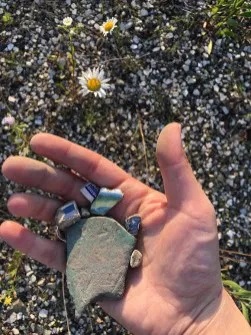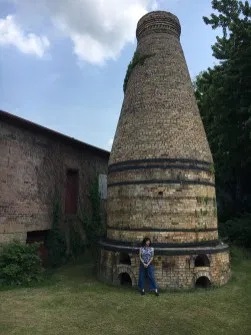Summer Research Report: Catherine Acosta
We rely and many individuals and foundations to support our multi-faceted Emerging Scholars Program, among them the Marie and John Zimmermann Fund. Catherine Acosta received one of our 2017 Zimmermann Research Grant recipient to assist with her study of the history of the pottery industry in Ohio. Catherine’s project is connected to her master’s thesis on American industrial designer and artist Viktor Schreckengost, a prominent designer for mid-20th-century dinnerware. Born in Sebring, OH, Schreckengost created designs for the local potteries. During Catherine’s travels in eastern Ohio, she visited sites in Sebring, Salem, East Liverpool, and Cleveland.

Catherine Acosta
Catherine is a graduate student in her final year at the in the Master’s degree of the History of Design and Curatorial Studies at the Parsons School of Design and the Cooper-Hewitt, Smithsonian Design Museum. A native of Los Angeles, she received a BFA from the School of the Art Institute of Chicago. After college, she worked at the Glessner and Clarke House Museums before moving to New York City to pursue graduate work. As a hobby, she started selling mid-century dinnerware and home décor on Etsy, which fostered a love for the design history of that era and led to her research project. The Zimmermann Fund’s generous support through the Decorative Arts Trust allowed Catherine to spend a week exploring eastern Ohio’s ceramic history.
Catherine reports: “I traveled to Sebring and Salem, where Schreckengost designed for American Limoges and the Salem China Co. I also visited East Liverpool, the largest center for American pottery production in the 19th and 20th centuries, and Cleveland, where Schreckengost lived and worked most of his life. I poured over rich archives, and in some cases, catalogued never-before-seen materials.
“The Sebring Historical Society is housed in the Art Deco Strand Theatre near where most of the local potteries were located. Sebring was Schreckengost’s hometown. Founded as a pottery town in 1900, the community helped define his artistic identity. His father was a potter, a career both of his brothers followed as well. The Historical Society is crammed with Schreckengost-designed objects, ranging from dinnerware to pedal cars and bicycles. I spent a day exploring objects and the Sebring pottery archive. By its nature, the pottery industry can be elusive for historians: many potteries, along with all their equipment and records, have succumbed to fire. That is not to say evidence of these enterprises does not survive. The weedy grounds outside the theatre were covered in glinting shards as far as you could see. While gathering some of these treasures, I also stumbled on large red brick rings in the ground, the foundations of the enormous beehive kilns that produced Schreckengost dinnerware.
“In Salem, I had the distinct honor to be the first researcher to climb the rickety stairs to the attic of the Salem Historical Society, where I discovered several unopened boxes of Salem China Co. corporate archives. Containing Depression-era marketing materials, internal newsletters, and original photographs of pottery workers, this collection helped me build a case study of the pottery industry in the 1930s, detailing executive decision making, design objectives, and Schreckengost’s activities as a contracted designer.
“The East Liverpool Museum of Ceramics, located on the Ohio River near the juncture of Ohio, Pennsylvania, and West Virginia, helped further contextualize the broader tri-state pottery industry, which began in the 1830s. East Liverpool was known as the pottery capital of the U.S. for over a century. Through this visit I gained a more nuanced sense of the variety of commercial ceramics made in the region and of the industrial pottery process and explored one of the few remaining beehive kilns.
“I would like to extend my thanks to the Zimmermann Fund and Decorative Arts Trust for this invaluable opportunity to help tell this overlooked but important chapter in American design and industrial history.”
We are most grateful for the Zimmermann Fund’s continuing support of the Trust’s Emerging Scholars Program through Catherine’s research grant. We are pleased to announce that Catherine will present her findings during our Emerging Scholars Colloquium on January 21, 2018, following our annual Antiques Weekend program. Registration opens soon, and we encourage all decorative arts aficionados and scholars to join us for a series of presentations highlighting the noteworthy results of the Trust’s research grant program!
About The Decorative Arts Trust Bulletin
Formerly known as the "blog,” the Bulletin features new research and scholarship, travelogues, book reviews, and museum and gallery exhibitions. The Bulletin complements The Magazine of the Decorative Arts Trust, our biannual members publication.













